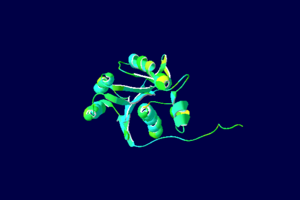Sandbox Reserved 312
From Proteopedia
| Line 4: | Line 4: | ||
{{STRUCTURE_2fbv| PDB=2fbv | SCENE= }} | {{STRUCTURE_2fbv| PDB=2fbv | SCENE= }} | ||
| - | Werner (WRN) protein is one of the five human RecQDNA helicases | + | Werner (WRN) protein is one of the five human RecQDNA helicases. This enzyme has a helicases function (unwinding the DNA helix) and a nuclease function (degrading), which allows for deletion of mutation and proofreading. The WRN has a functional exonuclease domain located on the N-terminus. WRN protein protects human from cancer; as well as, premature aging. |
=Function= | =Function= | ||
| - | This protein plays a major role in DNA metabolic pathway. WRN has activity of ATPase, helicases and exonuclease. <ref name= "Bukowy"> PMID: 16622405 </ref> | + | This protein plays a major role in DNA metabolic pathway, which perform DNA replication, recombination, and repair.. WRN has activity of ATPase, helicases and exonuclease. <ref name= "Bukowy"> PMID: 16622405 </ref> |
WRN exonuclease functions on different structures of a DNA substrate.<ref name= "Perry"> PMID: 16622405 </ref> | WRN exonuclease functions on different structures of a DNA substrate.<ref name= "Perry"> PMID: 16622405 </ref> | ||
| - | However, WRN exonuclease can be blocked by oxidatively induced base lesion (damaged by disease tissue). | + | However, WRN exonuclease can be blocked by oxidatively induced base lesion (damaged by disease tissue). The homodimer protein Ku binds to the broken double-stranded DNA, stimulating the WRN exonuclease to bypass the lesion. However, in non-digested strands the process is blocked by the lesion. |
=Structure= | =Structure= | ||
| Line 21: | Line 21: | ||
[[Image:Testa.png|300px]] | [[Image:Testa.png|300px]] | ||
=Clinical significance= | =Clinical significance= | ||
| - | + | The build up of oxidatively induced base in DNA the gene coding for WRN is mutated a autosomal recessive disorder causing rapid aging(osteoporosis, atherosclerosis and cancer). This is known as Werner syndrome which appears at puberty. | |
=Reference= | =Reference= | ||
<references/> | <references/> | ||
<references/"Bukowy"/WRN Exonuclease activity is blocked by specific oxidatively induced base lesions positioned in either DNA strand> | <references/"Bukowy"/WRN Exonuclease activity is blocked by specific oxidatively induced base lesions positioned in either DNA strand> | ||
Revision as of 05:34, 30 March 2011
| This Sandbox is Reserved from January 10, 2010, through April 10, 2011 for use in BCMB 307-Proteins course taught by Andrea Gorrell at the University of Northern British Columbia, Prince George, BC, Canada. |
To get started:
More help: Help:Editing |
| |||||||||
| 2fbv, resolution 2.40Å () | |||||||||
|---|---|---|---|---|---|---|---|---|---|
| Ligands: | |||||||||
| Gene: | WRN, RECQ3, RECQL2 (Homo sapiens) | ||||||||
| Related: | 2fbt, 2fbx, 2fby, 2fc0 | ||||||||
| |||||||||
| |||||||||
| Resources: | FirstGlance, OCA, RCSB, PDBsum | ||||||||
| Coordinates: | save as pdb, mmCIF, xml | ||||||||
Werner (WRN) protein is one of the five human RecQDNA helicases. This enzyme has a helicases function (unwinding the DNA helix) and a nuclease function (degrading), which allows for deletion of mutation and proofreading. The WRN has a functional exonuclease domain located on the N-terminus. WRN protein protects human from cancer; as well as, premature aging.
Contents |
Function
This protein plays a major role in DNA metabolic pathway, which perform DNA replication, recombination, and repair.. WRN has activity of ATPase, helicases and exonuclease. [1] WRN exonuclease functions on different structures of a DNA substrate.[2] However, WRN exonuclease can be blocked by oxidatively induced base lesion (damaged by disease tissue). The homodimer protein Ku binds to the broken double-stranded DNA, stimulating the WRN exonuclease to bypass the lesion. However, in non-digested strands the process is blocked by the lesion.
Structure
WRN is a enzyme with both magnesium and ATP-dependent DNA-helicase activity with a 3'->5' exonuclease activity towards double-stranded DNA. [2] Magnesium
Active Site
Substrate-Binding Site
Clinical significance
The build up of oxidatively induced base in DNA the gene coding for WRN is mutated a autosomal recessive disorder causing rapid aging(osteoporosis, atherosclerosis and cancer). This is known as Werner syndrome which appears at puberty.
Reference
- ↑ Perry JJ, Yannone SM, Holden LG, Hitomi C, Asaithamby A, Han S, Cooper PK, Chen DJ, Tainer JA. WRN exonuclease structure and molecular mechanism imply an editing role in DNA end processing. Nat Struct Mol Biol. 2006 May;13(5):414-22. Epub 2006 Apr 23. PMID:16622405 doi:http://dx.doi.org/10.1038/nsmb1088
- ↑ 2.0 2.1 Perry JJ, Yannone SM, Holden LG, Hitomi C, Asaithamby A, Han S, Cooper PK, Chen DJ, Tainer JA. WRN exonuclease structure and molecular mechanism imply an editing role in DNA end processing. Nat Struct Mol Biol. 2006 May;13(5):414-22. Epub 2006 Apr 23. PMID:16622405 doi:http://dx.doi.org/10.1038/nsmb1088
<references/"Bukowy"/WRN Exonuclease activity is blocked by specific oxidatively induced base lesions positioned in either DNA strand>


